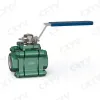What is the difference between 2pc and 3pc ball valves?
A ball valve is a type of valve that controls the flow of a liquid or gas by means of a rotary ball with a hole through its center. It is one of the most commonly used valves in various industries due to its reliability, versatility, and ease of operation. Two of the most popular configurations of ball valves are the 2-piece (2pc) and 3-piece (3pc) ball valves. While they serve the same fundamental purpose, there are several key differences between them.
1. Construction: The primary difference between 2pc and 3pc ball valves lies in their construction. As the name suggests, a 2pc ball valve is constructed from two main pieces – the body and the cap. These two pieces are typically bolted or threaded together. On the other hand, a 3pc ball valve consists of three main pieces – the body, the cap, and an intermediate connector piece. The body and cap are each manufactured as separate parts and are connected via bolts or threads to the intermediate connector piece.
2. Ease of Maintenance: One of the significant advantages of 3pc ball valves over 2pc ball valves is their ease of maintenance. Because 3pc ball valves are constructed from three separate pieces, they can be disassembled more easily for cleaning, repairs, or component replacement. This is particularly beneficial in applications where frequent maintenance is required or where the valve is installed in a hard-to-reach location.

3. Repairability: Similarly, the modular design of 3pc ball valves makes them more repairable compared to 2pc ball valves. If a component of a 3pc ball valve, such as the seat or seals, becomes worn or damaged, it can often be replaced individually without having to replace the entire valve assembly. This can result in cost savings and reduced downtime during maintenance activities.
4. Pressure Rating: In general, 3pc floating ball valves tend to have higher pressure ratings compared to 2pc ball valves. This is because the additional piece in the construction of 3pc ball valves provides added structural reinforcement, allowing them to withstand higher pressures without failure. As a result, 3pc ball valves are often preferred in applications where high-pressure conditions are encountered.
5. Cost: Due to their more complex construction and higher pressure ratings, 3pc ball valves are typically more expensive than 2pc ball valves. The additional components and manufacturing processes involved in producing 3pc ball valves contribute to their higher cost. However, the increased durability, ease of maintenance, and repairability of 3pc ball valves may justify the higher initial investment in certain applications.
6. Application: Both 2pc and 3pc ball valves are used in a wide range of industrial applications, including oil and gas, chemical processing, water treatment, and HVAC systems. The choice between the two depends on factors such as operating pressure, temperature, flow rate, maintenance requirements, and budget constraints. In general, 3pc ball valves are preferred in high-pressure applications or environments where frequent maintenance is anticipated, while 2pc ball valves may be suitable for lower-pressure applications where cost is a primary consideration.
In conclusion, while 2pc and 3pc ball valves serve the same basic function of controlling flow in a piping system, they differ in construction, maintenance requirements, pressure ratings, cost, and application suitability. Understanding these differences is crucial for selecting the most appropriate ball valve for a specific industrial application.


